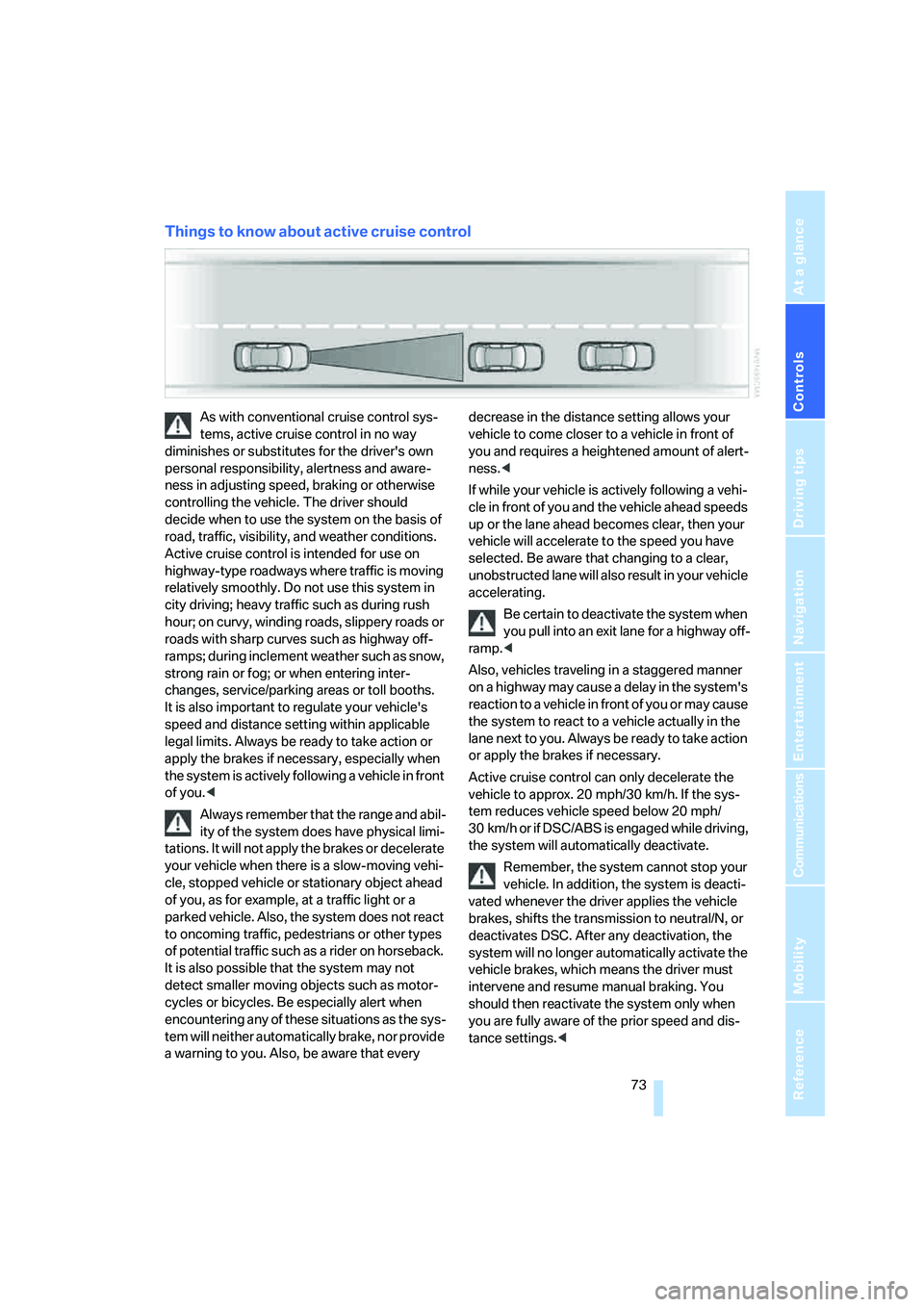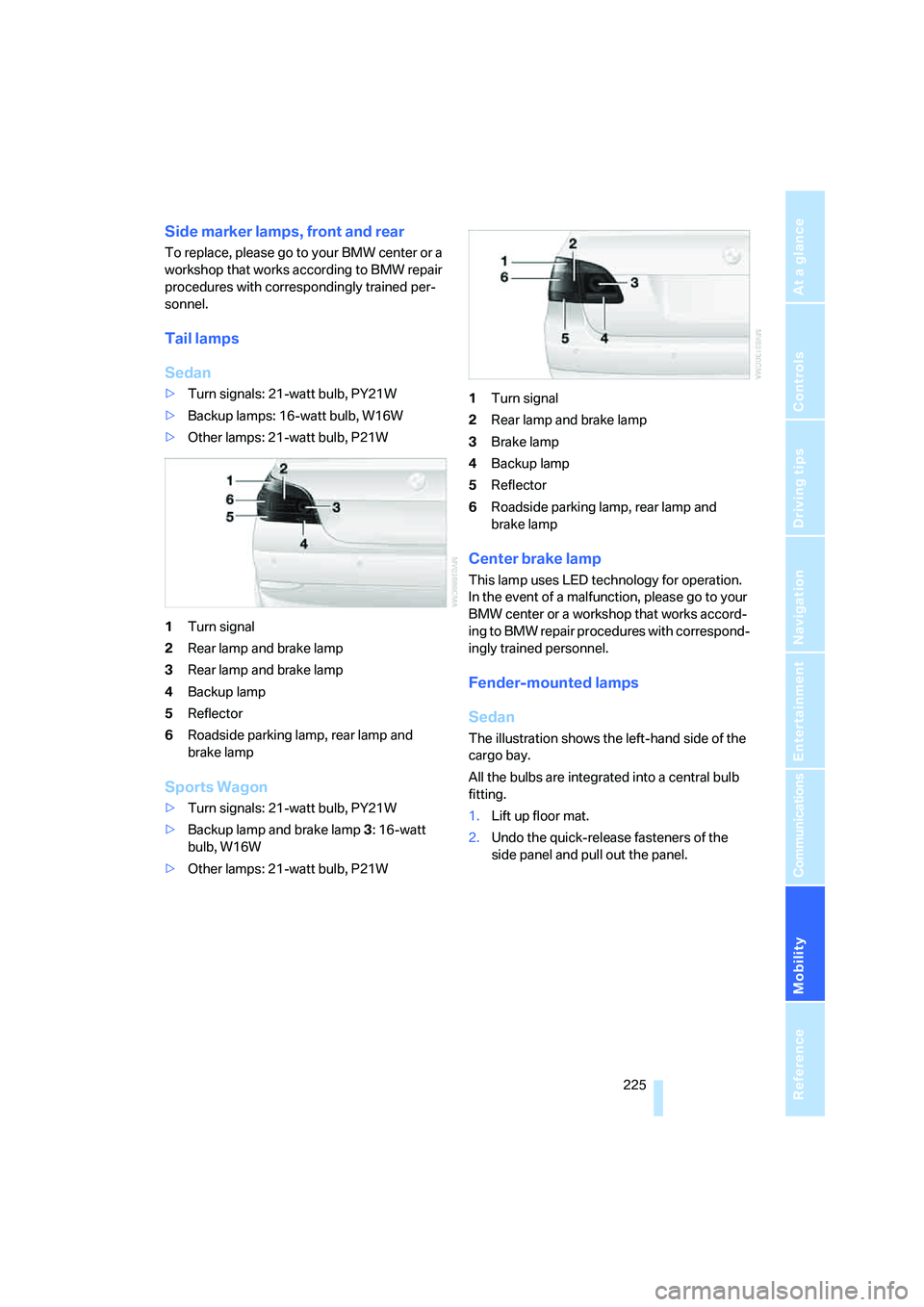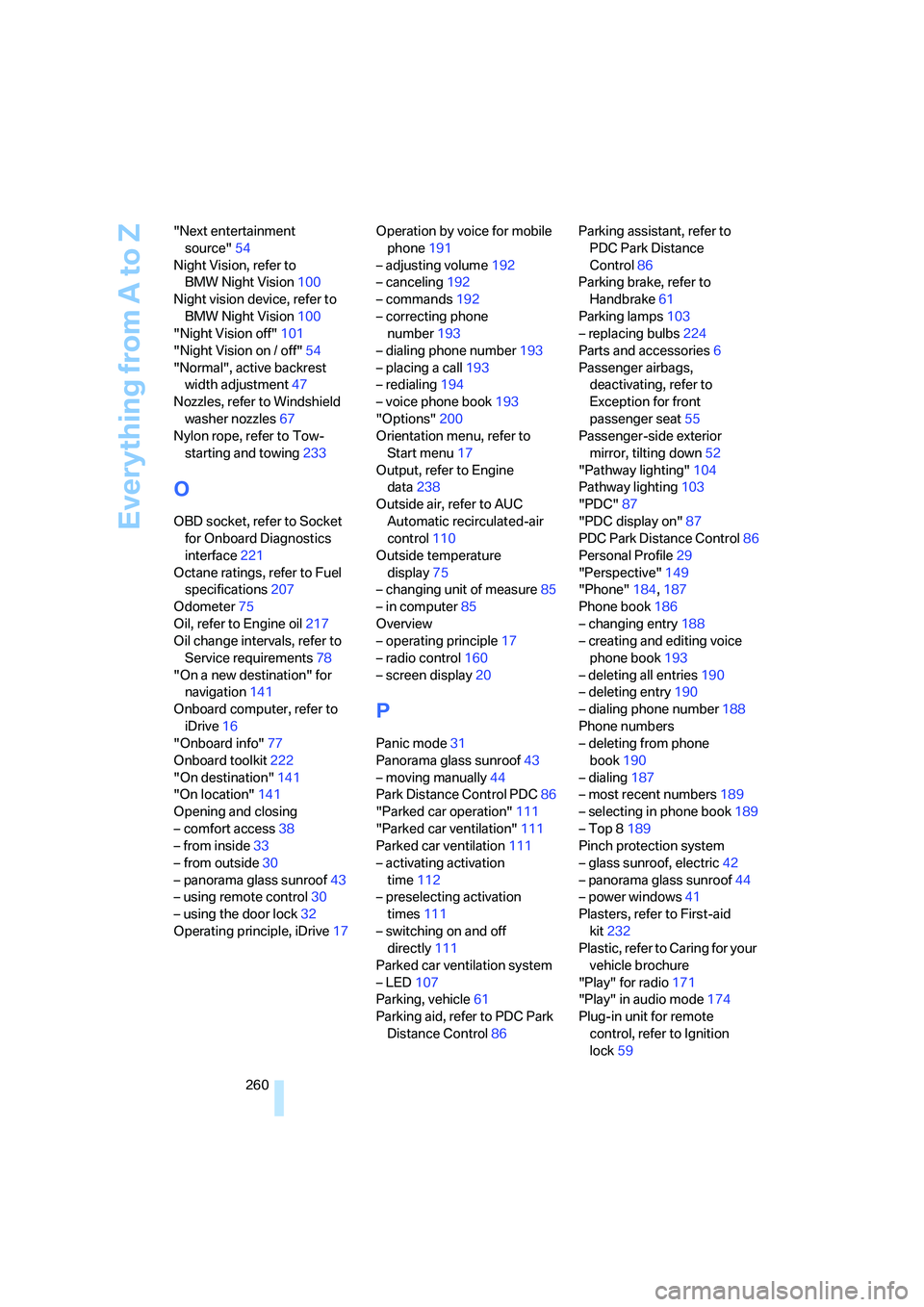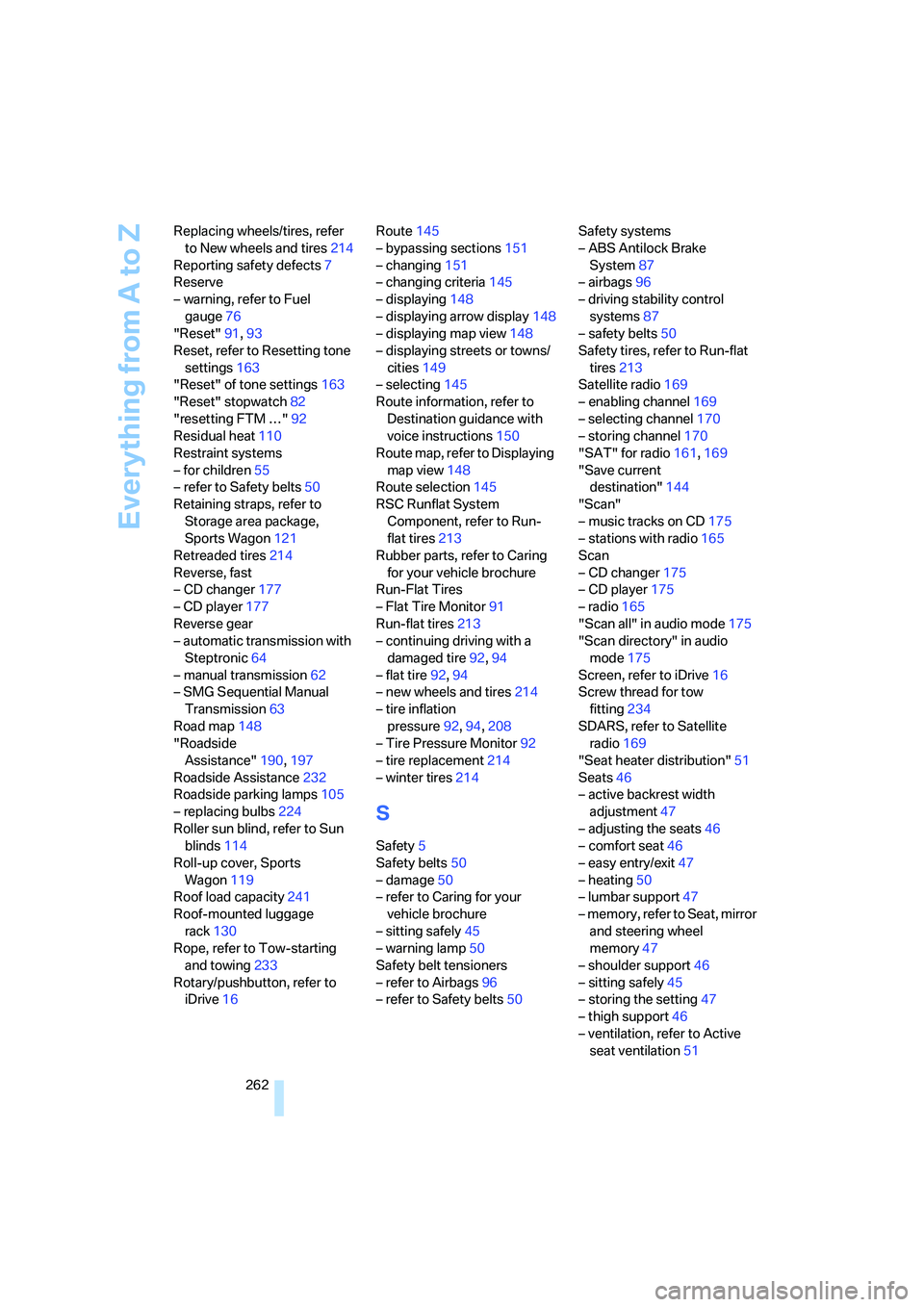2007 BMW 530I parking brake
[x] Cancel search: parking brakePage 63 of 273

Controls
61Reference
At a glance
Driving tips
Communications
Navigation
Entertainment
Mobility
Avoid frequent starting in quick succes-
sion or repeated starting attempts in
which the engine does not start. Otherwise, the
fuel is not burned or inadequately burned and
there is a danger of overheating and damaging
the catalytic converter.<
Switching off engine
Do not remove the remote control from
the ignition lock while the vehicle is roll-
ing, otherwise the steering-wheel lock would
engage while steering.
When leaving the vehicle, always take the
remote control with you.
When parking on a downhill incline, apply the
handbrake, otherwise the vehicle could roll
away.<
Manual transmission
1.Briefly press the Start/Stop button with the
vehicle stopped.
2.Shift into first gear or reverse.
3.Apply the handbrake.
SMG Sequential Manual
Transmission*
1.Apply the handbrake.
2.Engage a driving position.
3.Briefly press the Start/Stop button.
If N is engaged when switching off the
engine, this will be pointed out to you opti-
cally and acoustically.
Automatic transmission*
1.Select selector lever position P with the
vehicle stopped.
2.Briefly press the Start/Stop button.
Handbrake
The handbrake is primarily intended to prevent
the vehicle from rolling while parked; it brakes
the rear wheels.
Indicator lamp
The indicator lamp lights up, and a sig-
nal also sounds when starting off. The
handbrake is applied.
Indicator lamp for Canadian models.
Engaging
The lever locks in position automatically.
Releasing
Pull slightly upwards, press the button and
lower the lever.
If exceptional circumstances should
make it necessary to apply the handbrake
while the vehicle is in motion, do not pull it too
strongly. In doing so, continuously press the
button of the handbrake lever. Otherwise
excessive pressure can lead to the rear wheels
locking up and loss of traction – fishtailing – at
the rear axle.<
To prevent corrosion and one-sided brak-
ing action, occasionally apply the hand-
brake lightly when the vehicle is slowly coming
to a stop if the traffic conditions are suitable.
The brake lamps do not light up when the hand-
brake is applied.<
Page 75 of 273

Controls
73Reference
At a glance
Driving tips
Communications
Navigation
Entertainment
Mobility
Things to know about active cruise control
As with conventional cruise control sys-
tems, active cruise control in no way
diminishes or substitutes for the driver's own
personal responsibility, alertness and aware-
ness in adjusting speed, braking or otherwise
controlling the vehicle. The driver should
decide when to use the system on the basis of
road, traffic, visibility, and weather conditions.
Active cruise control is intended for use on
highway-type roadways where traffic is moving
relatively smoothly. Do not use this system in
city driving; heavy traffic such as during rush
hour; on curvy, winding roads, slippery roads or
roads with sharp curves such as highway off-
ramps; during inclement weather such as snow,
strong rain or fog; or when entering inter-
changes, service/parking areas or toll booths.
It is also important to regulate your vehicle's
speed and distance setting within applicable
legal limits. Always be ready to take action or
apply the brakes if necessary, especially when
the system is actively following a vehicle in front
of you.<
Always remember that the range and abil-
ity of the system does have physical limi-
tations. It will not apply the brakes or decelerate
your vehicle when there is a slow-moving vehi-
cle, stopped vehicle or stationary object ahead
of you, as for example, at a traffic light or a
parked vehicle. Also, the system does not react
to oncoming traffic, pedestrians or other types
of potential traffic such as a rider on horseback.
It is also possible that the system may not
detect smaller moving objects such as motor-
cycles or bicycles. Be especially alert when
encountering any of these situations as the sys-
tem will neither automatically brake, nor provide
a warning to you. Also, be aware that every decrease in the distance setting allows your
vehicle to come closer to a vehicle in front of
you and requires a heightened amount of alert-
ness.<
If while your vehicle is actively following a vehi-
cle in front of you and the vehicle ahead speeds
up or the lane ahead becomes clear, then your
vehicle will accelerate to the speed you have
selected. Be aware that changing to a clear,
unobstructed lane will also result in your vehicle
accelerating.
Be certain to deactivate the system when
you pull into an exit lane for a highway off-
ramp.<
Also, vehicles traveling in a staggered manner
on a highway may cause a delay in the system's
reaction to a vehicle in front of you or may cause
the system to react to a vehicle actually in the
lane next to you. Always be ready to take action
or apply the brakes if necessary.
Active cruise control can only decelerate the
vehicle to approx. 20 mph/30 km/h. If the sys-
tem reduces vehicle speed below 20 mph/
30 km/h or if DSC/ABS is engaged while driving,
the system will automatically deactivate.
Remember, the system cannot stop your
vehicle. In addition, the system is deacti-
vated whenever the driver applies the vehicle
brakes, shifts the transmission to neutral/N, or
deactivates DSC. After any deactivation, the
system will no longer automatically activate the
vehicle brakes, which means the driver must
intervene and resume manual braking. You
should then reactivate the system only when
you are fully aware of the prior speed and dis-
tance settings.<
Page 128 of 273

Things to remember when driving
126
Things to remember when driving
Break-in period
Moving parts need breaking-in time to adjust to
each other. To ensure that your vehicle contin-
ues to provide optimized economy of operation
throughout an extended service life, we request
that you devote careful attention to the follow-
ing section.
Engine and differential
Always obey all official speed limits.
Up to 1,200 miles/2,000 km
Drive at changing engine and driving speeds,
however do not exceed 4,500 rpm or 100 mph/
160 km/h.
Avoid full-throttle operation and use of the
transmission's kick-down mode during these
initial miles.
From 1,200 miles/2,000 km
The engine and vehicle speed can gradually be
increased.
SMG Sequential Manual Transmission
Do not use the acceleration assistant during the
break-in period, refer to page64.
Tires
Due to technical factors associated with their
manufacture, tires do not achieve their full trac-
tion potential until after an initial break-in
period. Therefore, drive reservedly during the
first 200 miles/300 km.
Brake system
Brakes require an initial break-in period of
approx. 300 miles/500 km to achieve optimized
contact and wear patterns between brake pads
and rotors. Drive in a reserved manner during
this break-in period.
Clutch
The function of the clutch is only at its opti-
mized level after a distance driven of approx.
300 miles/500 km.During this break-in period,
engage the clutch gently.
Following part replacement
Observe the break-in instructions again if com-
ponents mentioned above must be replaced
after subsequent driving operation.
General driving notes
Closing luggage compartment lid/
tailgate
Operate the vehicle only when the lug-
gage compartment lid/tailgate is com-
pletely closed. Otherwise, exhaust fumes could
enter the interior of the vehicle.<
If special circumstances should make it abso-
lutely necessary to operate the vehicle with the
luggage compartment lid/tailgate open:
1.Close all windows and the glass sunroof or
panorama glass sunroof.
2.Increase the air volume of the automatic cli-
mate control to a high level, refer to
page109.
Hot exhaust system
As in all vehicles, extremely high temper-
atures are generated on the exhaust sys-
tem. Do not remove the heat shields installed
adjacent to it, and never apply undercoating to
them. When driving, standing at idle and while
parking take care to avoid possible contact
between the hot exhaust system and any highly
flammable materials such as hay, leaves, grass,
etc. Such contact could lead to a fire, and with it
the risk of serious property damage as well as
personal injury. Do not touch hot exhaust tail
pipes. Otherwise there is a risk of burns.<
Page 227 of 273

Mobility
225Reference
At a glance
Controls
Driving tips
Communications
Navigation
Entertainment
Side marker lamps, front and rear
To replace, please go to your BMW center or a
workshop that works according to BMW repair
procedures with correspondingly trained per-
sonnel.
Tail lamps
Sedan
>Turn signals: 21-watt bulb, PY21W
>Backup lamps: 16-watt bulb, W16W
>Other lamps: 21-watt bulb, P21W
1Turn signal
2Rear lamp and brake lamp
3Rear lamp and brake lamp
4Backup lamp
5Reflector
6Roadside parking lamp, rear lamp and
brake lamp
Sports Wagon
>Turn signals: 21-watt bulb, PY21W
>Backup lamp and brake lamp 3: 16-watt
bulb, W16W
>Other lamps: 21-watt bulb, P21W1Turn signal
2Rear lamp and brake lamp
3Brake lamp
4Backup lamp
5Reflector
6Roadside parking lamp, rear lamp and
brake lamp
Center brake lamp
This lamp uses LED technology for operation.
In the event of a malfunction, please go to your
BMW center or a workshop that works accord-
ing to BMW repair procedures with correspond-
ingly trained personnel.
Fender-mounted lamps
Sedan
The illustration shows the left-hand side of the
cargo bay.
All the bulbs are integrated into a central bulb
fitting.
1.Lift up floor mat.
2.Undo the quick-release fasteners of the
side panel and pull out the panel.
Page 262 of 273

Everything from A to Z
260 "Next entertainment
source"54
Night Vision, refer to
BMW Night Vision100
Night vision device, refer to
BMW Night Vision100
"Night Vision off"101
"Night Vision on / off"54
"Normal", active backrest
width adjustment47
Nozzles, refer to Windshield
washer nozzles67
Nylon rope, refer to Tow-
starting and towing233
O
OBD socket, refer to Socket
for Onboard Diagnostics
interface221
Octane ratings, refer to Fuel
specifications207
Odometer75
Oil, refer to Engine oil217
Oil change intervals, refer to
Service requirements78
"On a new destination" for
navigation141
Onboard computer, refer to
iDrive16
"Onboard info"77
Onboard toolkit222
"On destination"141
"On location"141
Opening and closing
– comfort access38
– from inside33
– from outside30
– panorama glass sunroof43
– using remote control30
– using the door lock32
Operating principle, iDrive17Operation by voice for mobile
phone191
– adjusting volume192
– canceling192
– commands192
– correcting phone
number193
– dialing phone number193
– placing a call193
– redialing194
– voice phone book193
"Options"200
Orientation menu, refer to
Start menu17
Output, refer to Engine
data238
Outside air, refer to AUC
Automatic recirculated-air
control110
Outside temperature
display75
– changing unit of measure85
– in computer85
Overview
– operating principle17
– radio control160
– screen display20
P
Panic mode31
Panorama glass sunroof43
– moving manually44
Park Distance Control PDC86
"Parked car operation"111
"Parked car ventilation"111
Parked car ventilation111
– activating activation
time112
– preselecting activation
times111
– switching on and off
directly111
Parked car ventilation system
– LED107
Parking, vehicle61
Parking aid, refer to PDC Park
Distance Control86Parking assistant, refer to
PDC Park Distance
Control86
Parking brake, refer to
Handbrake61
Parking lamps103
– replacing bulbs224
Parts and accessories6
Passenger airbags,
deactivating, refer to
Exception for front
passenger seat55
Passenger-side exterior
mirror, tilting down52
"Pathway lighting"104
Pathway lighting103
"PDC"87
"PDC display on"87
PDC Park Distance Control86
Personal Profile29
"Perspective"149
"Phone"184,187
Phone book186
– changing entry188
– creating and editing voice
phone book193
– deleting all entries190
– deleting entry190
– dialing phone number188
Phone numbers
– deleting from phone
book190
– dialing187
– most recent numbers189
– selecting in phone book189
– Top 8189
Pinch protection system
– glass sunroof, electric42
– panorama glass sunroof44
– power windows41
Plasters, refer to First-aid
kit
232
Plastic, refer to Caring for your
vehicle brochure
"Play" for radio171
"Play" in audio mode174
Plug-in unit for remote
control, refer to Ignition
lock59
Page 264 of 273

Everything from A to Z
262 Replacing wheels/tires, refer
to New wheels and tires214
Reporting safety defects7
Reserve
– warning, refer to Fuel
gauge76
"Reset"91,93
Reset, refer to Resetting tone
settings163
"Reset" of tone settings163
"Reset" stopwatch82
"resetting FTM …"92
Residual heat110
Restraint systems
– for children55
– refer to Safety belts50
Retaining straps, refer to
Storage area package,
Sports Wagon121
Retreaded tires214
Reverse, fast
– CD changer177
– CD player177
Reverse gear
– automatic transmission with
Steptronic64
– manual transmission62
– SMG Sequential Manual
Transmission63
Road map148
"Roadside
Assistance"190,197
Roadside Assistance232
Roadside parking lamps105
– replacing bulbs224
Roller sun blind, refer to Sun
blinds114
Roll-up cover, Sports
Wagon119
Roof load capacity241
Roof-mounted luggage
rack130
Rope, refer to Tow-starting
and towing233
Rotary/pushbutton, refer to
iDrive16Route145
– bypassing sections151
– changing151
– changing criteria145
– displaying148
– displaying arrow display148
– displaying map view148
– displaying streets or towns/
cities149
– selecting145
Route information, refer to
Destination guidance with
voice instructions
150
Route map, refer to Displaying
map view148
Route selection145
RSC Runflat System
Component, refer to Run-
flat tires213
Rubber parts, refer to Caring
for your vehicle brochure
Run-Flat Tires
– Flat Tire Monitor91
Run-flat tires213
– continuing driving with a
damaged tire92,94
– flat tire92,94
– new wheels and tires214
– tire inflation
pressure92,94,208
– Tire Pressure Monitor92
– tire replacement214
– winter tires214
S
Safety5
Safety belts50
– damage50
– refer to Caring for your
vehicle brochure
– sitting safely45
– warning lamp50
Safety belt tensioners
– refer to Airbags96
– refer to Safety belts50Safety systems
– ABS Antilock Brake
System87
– airbags96
– driving stability control
systems87
– safety belts50
Safety tires, refer to Run-flat
tires213
Satellite radio169
– enabling channel169
– selecting channel170
– storing channel170
"SAT" for radio161,169
"Save current
destination"144
"Scan"
– music tracks on CD175
– stations with radio165
Scan
– CD changer175
– CD player175
– radio165
"Scan all" in audio mode175
"Scan directory" in audio
mode175
Screen, refer to iDrive16
Screw thread for tow
fitting234
SDARS, refer to Satellite
radio169
"Seat heater distribution"51
Seats46
– active backrest width
adjustment47
– adjusting the seats46
– comfort seat46
– easy entry/exit47
– heating50
– lumbar support47
– memory, refer to Seat, mirror
and steering wheel
memory47
– shoulder support46
– sitting safely45
– storing the setting47
– thigh support46
– ventilation, refer to Active
seat ventilation51